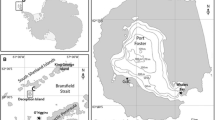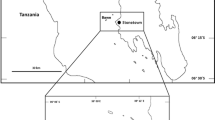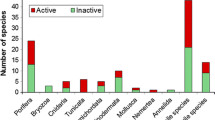Abstract
The feeding deterrent properties of hexane, ethyl acetate, and butanol lipophilic extracts of 16 species of Bermudian sponges presented to the sergeant major,Abudefduf saxatilus, and the Bermuda bream,Diplodus bermudensis, were investigated in the laboratory. The sponges investigated spanned a variety of different color morphs and were representative of patch reef, mangrove, rock wall, soft bottom, seagrass, and cave habitats. Six of the 16 sponges (36%) had at least one extract that deterred feeding byA. saxatilus, while only one of 16 sponges (6%) had an extract that deterred feeding byD. bermudensis. Among those sponges that deterred feeding in one or both fish, deterrence was most frequently associated with compounds extracted in ethyl acetate (moderately polar). Butanol extracts (most polar) were active in only half as many instances, while in only one case was a hexane extract (least polar) active. Both brighly colored (yellow, orange–yellow, gray–blue, purple–brown) and weakly colored (dull brown, pinkish white) sponges had hexane, ethyl acetate, or butanol extracts that were deterrent. Generally the numbers of sponges with bioactive lipophilic extracts that caused feeding deterrence in fish was low. This may be related to Bermuda being located just within or beyond the extreme northern range of many tropical fish and invertebrates, and therefore sponges are exposed to reduced levels of predation.
Similar content being viewed by others
REFERENCES
BAKER, B. J.,YOSHIDA, W. Y., andMC CLINTOCK, J. B. 1994. Chemical constitutents of four antarctic sponges in McMurdo Sound, Antarctica.Antarct. J. U.S. 29:153–155.
BAKUS, G. J., andGREEN, G. 1974. Toxicity in sponges and holothurians: A geographic pattern.Science 185:951–953.
BAKUS, G. J.,TARGETT, N. M., andSCHULTE, B. 1986. Chemical ecology of marine organisms: An overview.J. Chem. Ecol. 12:951–987.
BERGQUIST, P. R. 1978. Sponges. University of California Press, Los Angeles, California, 268 pp.
BOBZIN, S. C., andFAULKNER, J. 1992. Chemistry and chemical ecology of the Bahamian spongeAplysina glacialis.J. Chem. Ecol. 18:309–332.
BRIGGS, J. C. 1974. Marine Zoogeography. McGraw-Hill, New York, 475 pp.
BUTLER, J. N.,BURNETT-HERKES, J.,KATES, R. W.,MC GOWAN, A., and O'RIORDAN, T. 1993. The Bermuda fisheries: A tragedy of the commons averted?Environment 35:6–15.
CHANAS, B., andPAWLIK, P. R. 1995. Defenses of Caribbean sponges against predatory reef fish: II. Spicules, tissue toughness and nutritional quality.Mar. Ecol. Prog. Ser. 127:195–211.
DAYTON, P. K.,ROBILLIARD, G. A.,PAINE, R. T., andDAYTON, L. B. 1974. Biological accommodation in the benthic community at McMurdo Sound, Antarctica.Ecol. Monogr. 44:105–128.
DE LAUBENFELS M. W. 1950. An ecological discussion of the sponges of Bermuda.Trans. Zool. Soc. 27:155–200.
DUFFY, J. E., andPAUL, V. J. 1992. Prey nutritional quality and the effectiveness of chemical defenses against tropical reef fish.Oecologia 90:333–339.
FAULKNER, D. J. 1995. Marine natural products.Nat. Prod. Rep. 12:223–269.
GREEN, G. 1977. Ecology of toxicity of marine sponges.Mar. Biol. 40:207–215.
GRODE, S. H., andCARDELLINA, J. H. II. 1984. Sesquiterpenes from the spongeDysidea etheria and the nudibranchHypselodoris zebra.J. Nat. Prod. 47:76–83.
HARRISON, F. W., andCOWDEN, R. R. 1976. Aspects of Sponge Biology. Academic Press, New York.
KONG, F., andFAULKNER, D. J. 1993. Leucettamols A and B, two antimicrobial lipids from the calcareous spongeLeucetta microraphis.J. Org. Chem. 58:970–971.
KOLTUN, V. M. 1970. Sponges of the arctic and antarctic: A faunistic review.Symp. Zool. Soc. London 25:285–297.
MC CLINTOCK, J. B. 1986. On estimating energetic values of prey: Implications in optimal diet models.Oecologia 70:161–162.
MC CLINTOCK, J. B. 1987. An investigation between the relationship between invertebrate predation and the biochemical composition, energy content, spicule armament and toxicity of sponges in the benthic community at McMurdo Sound, Antarctica.Mar. Biol. 94:479–487.
MC CLINTOCK, J. B. 1994. The trophic biology of antarctic echinoderms.Mar. Ecol. Prog. Ser. 111:191–202.
MC CLINTOCK, J. B.,BAKER B. J.,HAMANN, M.,SLATTERY, M.,KOPITZKE, R. W., andHEINE, J. N. 1994. Tube-foot chemotactic responses of the spongivorous sea starPerknaster fuscus to organic extracts of antarctic sponges.J. Chem. Ecol. 20:859–870.
MEYLAN, A. 1988. Spongivory in hawksbill turtles: A diet of glass.Science 239:393–395.
PAUL, V. J. 1992. Ecological Roles of Marine Natural Products. Comstock, Ithaca, New York.
PAWLIK, J. R. 1983. A sponge eating worm from Bermuda:Branchiosyllis oculata (Polychaeta: Syllidae).PSZNI Mar. Ecol. 4:65–79.
PAWLIK, J. R. 1993. Marine invertebrate chemical defenses.Chem. Rev. 93:1911–1922.
PAWLIK, J. R.,CHANAS, B.,TOONER R. J., andFENICAL W. 1995. Defenses of Caribbean sponges against predatory reef fish: I. Chemical deterrency.Mar. Ecol. Prog. Ser. 127:183–194.
PENNINGS, S. C.,PABLO, S. R.,PAUL, V. J., andDUFFY, J. E. 1994. Effects of secondary metabolites in different diets on feeding by three groups of consumers.J. Exp. Mar. Biol. Ecol. 180:137–149.
RANDALL, J. E., andHARTMAN, W. D. 1968. Sponge feeding fishes of the West-Indies.Mar. Biol. 1:216–225.
SLOAN, N. A. 1980. Aspects of feeding biology of asteroids.Oceanogr. Mar. Biol. Annu. Rev. 18:57–124.
STERRER, W. 1986. Marine Fauna and Flora of Bermuda. Systematic Guide to the Identification of Marine Organisms. John Wiley & Sons, New York.
STERRER, W. 1992. Bermuda's Marine Life. Island Press, Hamilton, Bermuda.
TEEYAPANT, R., andPROKSCH, P. 1993. Biotransformation of brominated compounds in the marine spongeVerongia aerophoba—evidence for an induced chemical defense?Naturwissenschaften 80:369–370.
THOMPSON, J. E.,WALKER R. P.,WRATTEN, S. J.,FAULKNER, D. J. 1982. A chemical defense mechanism for the nudibranchCadlina luteomarginata.Tetrahedron 38:1865–1873.
THOMPSON, J. E.,WALKER, R. P.,FAULKNER, D. J. 1985. Screening and bioassays for biologically-active substances from forty marine sponge species from San Diego, California, USA.Mar. Biol. 88:11–21.
VERMEIJ, G. J. 1978. Biogeography and Adaptation. Harvard University Press, Boston.
WULFF, J. L. 1995. Sponge-feeding by the Caribbean starfishOreaster reticulatus.Mar. Biol. 123:313–325.
ZAR, J. 1984. Biostatistical Analysis. Prentice Hall, Englewood Cliffs, New Jersey.
Author information
Authors and Affiliations
Rights and permissions
About this article
Cite this article
Mcclintock, B., Swenson, D., Trapido-Rosenthal, H. et al. Ichthyodeterrent Properties of Lipophilic Extracts from Bermudian Sponges. J Chem Ecol 23, 1607–1620 (1997). https://doi.org/10.1023/B:JOEC.0000006425.86488.8d
Issue Date:
DOI: https://doi.org/10.1023/B:JOEC.0000006425.86488.8d




